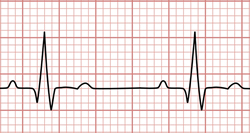
Sinus rhythm electrocardiogram
A contraction, from the Greek [συστολή] (systolí) meaning “contraction”, also [συστελλει] (systellei) meaning “to shrink, to shorten, or to draw together”.
It refers to the contraction of the heart. If you analyze a normal heartbeat (sinus rhythm), there are two systoles: an atrial systole, followed by a short interval, followed by the ventricular systole. The term systole is usually used in reference to the ventricular systole.
Systole was first recognized and named by Herophilus of Alexandria (325-255BC), most probably trough animal vivisection. Herophilus was accused of animal vivisection and the dissection of human cadavers. Because of this, some call Herophilus "The Father of Anatomy".
Galen of Pergamon (129AD - 200AD) used the term [συστελλεσθαι] meaning “contracted”.
The word in English was first used in the 16th century and was originally written as “sistole”, with an "i" instead of the accepted use today with a "y". The modern pronunciation in English follows the Greek pronunciation by ending the word in a long “e” as in “to be”.
Sources
1. "The Origin of Medical Terms" Skinner, HA 1970 Hafner Publishing Co.
2. "Medical Meanings - A Glossary of Word Origins" Haubrich, WD. ACP Philadelphia
3. "Dorlands's Illustrated Medical Dictionary" 26th Ed. W.B. Saunders 1994
4. "Greek anatomist Herophilus: the father of anatomy" Si-Yang, N. Anat Cell Biol. 2010; 43(4): 280–283
Note: Google Translate includes an icon that will allow you to hear the pronunciation of the word



